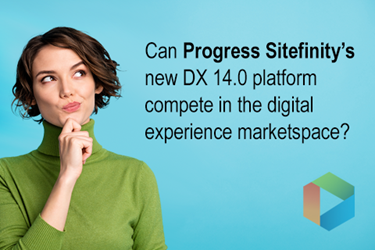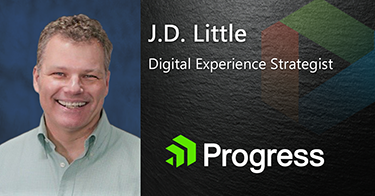Is Progress's Newest Sitefinity DX 14.0 Release an Attractive DXP Option?
In an already crowded marketplace, has Progress's Sitefinity DX 14.0 done enough to compete with the launch of their new composable digital experience platform solution?
With a global pandemic that has compelled organizations to adopt a cyber-first approach to product and service offerings, digital experience platform (DXP) vendors have been hard-pressed to respond by defining and delivering streamlined, innovative solutions to meet the demands. While some have been left scrambling to reinvent themselves to avoid fading into the shadows, most DXP vendors have adapted to match the accelerated pace of technological evolution.
Founded in 1981, Progress is a DXP developer of products that manage high-impact enterprise applications and is one of the agencies that has risen to the challenge in supporting businesses to fulfilling the voracious DX appetites of consumers and clients alike.
I was first introduced to Progress in 2014 when they acquired Telerik for $262.5M. The acquisition included a .NET toolbox, a mobile development platform, and a popular mid-market content management system called Sitefinity. Today, Progress Sitefinity defines itself as a flexible and extensible DXP platform that allows organizations to create digital experiences with new capabilities for low-code integration, chat-driven engagement, and enhanced headless content delivery.
On September 15, 2021, Progress announced the release of their new Composable DXP solution — Sitefinity DX 14.0.
What is a composable DXP solution? The term “composable DXP” recently emerged within the rapid progression of the digital experience platform market, a market that is still relatively in its infancy. The essential capabilities within a composable DXP revolve around the flexibilities that enable organizations to adjust to changing market needs more nimbly — capabilities like cloud support, a decoupled presentation layer, and flexible APIs, which are critical to satisfying unique business and market scaling requirements.
What’s New with Sitefinity DX 14.0?
Sitefinity DX’s version 14.0 is the foundation of the Sitefinity DX platform, with an increased number of add-ons available, including an Enterprise Package and new composable platform bundling.
Moreover, Sitefinity Insight analytics is now included in the Sitefinity DX 14.0 base solution to provide a more comprehensive view of users’ websites usage and dynamics. The Personalize, Test, and Optimize add-ons are available separately and utilize more of Sitefinity Insight’s capabilities for personalization and A/B testing.
|
Key New Features & Functionality
|
|
|
|
- NativeChat Chatbot widget
|
- Expanded SiteSync Functionality
|
- New Authentication Protocol
|
- External App Authorization
|
- User Groups Management for Multisite
|
- SEO Optimization WebIP Image Support
|
- Implementation for Content Block Sharing
|
- Responsive images for MVC /.NET Core widgets
|
- Enhanced Digital Media Analytics
|
- Sitefinity Component Framework
|
|
|
- Page Templates Management Redesign
|
- Introduction of the Navigation Widget
|
- Introduction of the Content List Widget
|
- New Auto-Generated Fiield for MVC and .NET Core Widgets
|
- Page and Widget-Based Personalization for the .NET Core Pages
|
|
Sitefinity DX 14.0 Official Release Notes
|
Interview with J.D. Little
 Already experiencing steady growth over the last few years and fresh off their latest release, I was delighted with the opportunity to sit down with J.D. Little, DX Strategist at Progress, to discuss a few of the impressive new features of 14.0 and Progress Sitefinity’s vision for the future.
Already experiencing steady growth over the last few years and fresh off their latest release, I was delighted with the opportunity to sit down with J.D. Little, DX Strategist at Progress, to discuss a few of the impressive new features of 14.0 and Progress Sitefinity’s vision for the future.
J.D. Little is a DX Strategist at Progress and an active communicator and educator through speaking engagements, blogs, articles, podcasts, interviews, and as a keynote speaker at various industry events. Beginning his career in traditional media technology, J.D. has been helping business leaders navigate the waves of disruptive innovation for more than 25 years.
Thank you J.D. for sharing your insights on the latest release of Progress Sitefinity DX 14.0 with our CMS-Connected audience!
 |
First off, congratulations on the new release! Let’s kick things off by having you share a few of the new capabilities and differentiators of Sitefinity DX 14.0.
|
 |
"Thanks, Gary. This release is the result of months of work and planning. We are excited about it, and we’re getting great responses from our customers and partners. We consider it a major leap forward, expanding the platform’s digital experience capabilities. There are several additions we’d like to highlight.
"First, with Sitefinity DX 14, we added a low-code integration layer to enable rapid MarTech system integration, including options to use predefined and custom events in Sitefinity to trigger actions in other systems. This provides a way to build a tightly connected ecosystem of key Marketing Automation services and data solutions communicating seamlessly with Sitefinity.
"We’ve also made the process of adding our NativeChat product to Sitefinity much easier. The NativeChat Sitefinity widget allows users to add chatbots directly to Sitefinity web pages and templates.
"Sitefinity DX 14 has enhanced headless content and presentation capabilities for experience management at scale. The Sitefinity headless API now includes layout and personalization metadata, as well as advanced caching for optimal end-user performance, extending experience management to any presentation channel that supports a page/widget model.
"We introduced multisite user groups, which allow the management of multiple sites with designated users and specific configurations. This meets a significant need for distributed organizations with a high number of sites under management. By leveraging user groups, customers can scale out their web presence without adding staff and spending more money.
"Finally, in the area of analytics, we’ve introduced new multi-touch content attribution models, including AI-driven attribution, which expand the rules system for more flexibility in audience segmentation."
|
 |
Paul Nashawaty, a senior analyst at Enterprise Strategy Group, said, “Content management was the underlying piece of any DX platform until organizations realized that it alone wasn’t enough.” Would you agree with this statement, and does the base Sitefinity DX coupled with the new composable packaging align with Paul’s view?
|
 |
"Absolutely. Paul has this exactly right. Recognizing the need to integrate components and systems to meet changes in market trends and consumer behavior has been a focus for Progress for some time now.
"I have a sports analogy for composability. Hockey great Wayne Gretzky used to say he was successful because he’d skate to where the puck was going to be. Business speakers loved to use that quote and have done so for years. With the current rate of innovation, however, by the time you get down the ice, you might find the puck has changed to a curling stone, so now you need a boom instead of a hockey stick. If you can’t switch tools easily, you can’t win. Maybe that’s more of a metaphor.
"Regardless, other than the great set of features it brings, Sitefinity DX 14 has also been repackaged with à la carte functional add-ons and bundle packages to support customers in building composable, cost-effective implementations."
|
 |
To help improve extensibility and allow integration with third-party services, version 14.0 introduces customers to the Service hooks module, which replaces the Webhooks module. Explain the difference between the two modules and the benefits of a Service hooks mechanism?
|
 |
"Previously, as part of our commitment to low-code and no-code integration, Webhooks were created as an easy way to send a unique URL to third-party systems. An event such as form completion or a completed login could send data to another system to create a CRM entry or a meeting invitation.
"Service hooks expand on that capability with more triggers and easier use. Events such as the publishing or unpublishing of a news item, blog, image, document, or video can now be triggers as well. However, the biggest benefit of service hooks is automation. Service Hooks allow more and easier ways to connect and integrate through custom microservices and low-code development middleware.
"Service hooks do everything webhooks did and more. In fact, Webhook actions are sub-items of Service hooks, so Webhooks are can actually be auto-migrated when Sitefinity customers upgrade to Sitefinity DX 14.0."
|
 |
Recent research from Progress shows that 35% of organizations haven’t implemented a DXP solution due in part to products on the market being far too complex and expensive, with underutilized features that add to the overall cost. Those are pretty significant reasons to overcome. How has version 14.0 addressed DXP deployment complexities and cost concerns?
|
 |
"For 40 years, Progress has been a software developer’s software developer, so we’ve always had the developer experience top of mind with each enhancement to Sitefinity. Sitefinity is traditionally easier to implement when measured against our competitors, and several of the success stories on the Progress website highlight that. The enhanced low-code and no-code options we’ve been talking about benefit DevOps as much as marketers by freeing them from code-heavy tasks and allowing business users to become less reliant on their services on a day-to-day basis.
"As for addressing deployment complexity, our PaaS cloud offering, Sitefinity Cloud, is a fully managed Platform as a Service, built on Microsoft Azure, and employs elastic automatic scalability in 18 Azure regions. There is no easier or cost-efficient implementation model available."
|
 |
In a recently published CMS-Connected article, CMS-Connected Wades Into the Forrester Wave Report for Agile CMS 2021, I found it odd that Sitefinity was bizarrely pushed off the report. Do you feel that Progress has done enough in version 14.0 to compete in the DXP and CMS market with the likes of Adobe, Acquia, Kentico, Optimizely, and Sitecore in the eyes of the Gartner and Forrester analysts?
|
 |
"We at Progress maintain a strong working relationship with many analysts, and we greatly value the conversations and guidance we’ve received from Forrester and Gartner this year and in years past and are in ongoing conversations with them to understand their criteria and how we match up to it. We’re extremely proud of this release and, although we can’t predict what the reports will say, we are very confident of our ability to compete against all those players you mention in the DXP market, as evidenced by the many customers we’ve been able to help with their digital transformations."
|
 |
What can you share with our audience about the future roadmap for the Sitefinity DX platform?
|
 |
"We have really exciting plans for Sitefinity as well as the full Progress portfolio supporting leading-edge DX. The next version of Sitefinity is expected to include a fully decoupled API-driven front end, based on a new .NET Core framework that is currently in Beta with several customers.
"We are expanding platform connectivity options with out-of-the-box connectors for selected third-party DAM systems, personalization options for ecommerce, and also pushing forward new applications of our new low code integration service. In the spirit of delivering composable capabilities, we have made a significant effort to support broader DX scenarios for enterprises, with other Progress products augmenting Sitefinity in areas of rapid U.I. and mobile development, digital decisioning, data connectors, and secure file transfer.
"Last but not least, we are incorporating more A.I.-based solutions in the portfolio, both internally developed for audience analytics and experience management, as well as integrating with a rich set of A.I. services provided by Azure."
|
My Final Thoughts
DXP customers demand highly personalized experiences that are intuitive, scalable, and delivered instantly through any digital channel they choose. They also demand value with a clear path towards an achievable return on their investment. Although returns on a DXP solution will differ across organizations and be influenced by various factors, companies that adopt an advanced feature-rich DXP can expect measurable cost savings and a reduced time-to-market.
Is the new Sitefinity release an attractive option for mid-market and enterprise-level organizations looking for a DXP solution? In my opinion, yes. Promoted as their base DX platform, Sitefinity DX 14.0 is a solid hybrid headless CMS option that enables users to create personalized experiences based on presentation-neutral content delivered across multiple channels.
For those Sitefinity customers considering an upgrade to 14.0, you’ll now have more flexibility in choosing only what capabilities you need. Progress Sitefinity has moved away from an edition-focused approach, where customers get all capabilities. Instead, they have adopted an à la carte approach, where select capabilities can be purchased without paying for what would never be used.
Recommended Next Step
Is the new Sitefinity DX a “best-fit” digital experience platform option? To get one step closer to answering that question, I recommend scheduling a personalized demo. Then, and only then, will you begin to determine a true best fit for your organization.

Gary Eisenstein
Gary has been working in the IT industry since 1993 and is the Principal Analyst at CMS-Connected, and the Founder and President of Falcon-Software. If you would like advice on how to evaluate a "best-fit" digital experience solution for your organization, Gary can be reached at gary.eisenstein@cms-connected.com.